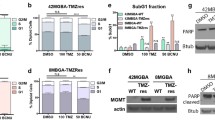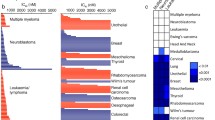Summary
The main cause for the failure of chemotherapeutic treatment of advanced cancer probably lies in the emergence of drug resistant clones. In the present study we compared the sensitivity to adriamycin (ADR) and the capacity of ADR uptake in two human neuroblastoma cell lines differing in properties relevant to metastatic potential, the GP2 and MB, of low- and high-malignancy phenotype, respectively.
Examination of the ADR effect onin vitro proliferative capacity of the two cell lines revealed a higher sensitivity of GP2 as compared to the MB variant.
Intracellular ADR accumulation was determined by fluorocytometry, spectrofluorometry and fluorescence microscopy. According to the three methods, the GP2 line cells, representing a low-malignancy phenotype, had a higher uptake ability than the MB cells, possessing a phenotype of higher aggressiveness.
The quantitative determination revealed that over a broad range of ADR concentrations, the GP2 cells accumulated 2–3.5 folds the amount of cytotoxic agent penetrating the MB cells. The FACS analysis showed that the cell population of each of the variants consisted of two subpopulations varying in their ability to accumulate ADR. In the GP2 line the high permeability subpopulation represented nearly half of the total cell population, whereas in the MB line this subpopulation represented a minority.
The correlation observed between ADR uptake capacity and sensitivity to the cytotoxic agent, as evidenced by its effect on proliferative capacity, suggests that the resistance of the MB cells is due to a P-G-P modification-related mechanism.
Similar content being viewed by others
Reference
Bradley G, Juranka PF, Ling V: Mechanism of a multidrug resistance. Biochim Biophys Acta 948: 87–128, 1988
Leibovici J, Michowitz M, Argaman H, Klein O, Klorin G, Hoenig S: A model for cancer treatment in advanced compared to early cancer. Anticancer Res 6: 1225–1230, 1986
Leibovici J, Klorin G, Huszar M, Hoenig S, Klein O, Pinchassov A: Sensitivity to thermochemotherapy of AKR lymphoma and B16 melanoma variants of malignancy. Clin Expl Metastasis 8: 33–46, 1990
Klorin G, Siegel A, Bar-Shira-Maymon B, Klein O, Leibovici J: Effect of hyperthermia and thermochemotherapy on primary and metastatic tumor cells of AKR lymphoma. Int J Exp Path 71: 469–477, 1990
Bar-Shira-Maymon B, Michowitz M, Gibli O, Klein O, Pinchassov A, Leibovici J: Effect of a membrane active agent on uptake of adriamycin in Lewis lung carinoma cells derived from ‘Primary’ and ‘Metastatic’ growths. Chemotherapy 38: 66–73, 1992
Young JL, Ries LG, Silverberg E, Horm JW, Miller RW: Cancer incidence survival and mortality for children under 15 years of age. Cancer 58: 598–602, 1986
Jaffe N: Neuroblastoma: Review of the literature and an examination of factors contributing to its enigmatic character. Cancer Treat Rev 3: 61–82, 1976
Coldman AJ, Fryer CJH, Elwood JM, Sonley MJ: Neuroblastoma: influence of age at diagnosis, stage, tumor site and sex on prognosis. Cancer 46: 18896–1901, 1980
Evans AE, D'Angio GJ, Propert K, Anderson J, Hann HL: Prognostic factors in neuroblastoma. Cancer 59: 1853–1859, 1987
Uchino J, Hata Y, Kasai Y: Stage IV-S neuroblastoma. J Pediatr Surg 13(2): 167–172, 1978
Breslow N, McCann B: Statistical estimation of prognosis for children with neurobolastoma. Cancer Res 31: 2098–3004, 1971
Nesbit ME: Advances and management of solid tumors in children. Cancer 65: 696–702, 1990
Nickerson HJ, Nesbit ME, Grosfeld JL, Baehner RL, Sather H, Hammond D: Comparison of stage IV and IV-S neuroblastoma in the first year of life. Med Pediatr Oncol 13: 261–268, 1985
Pinkerton CR, Zucker JM, Hartmann O, Pritchard J, Broadbent V, Jones PM, Breatnach F, Craft AE, Pearson ADJ, Wallendszus KR, Philip T: Short duration, high dose, alternating chemotherapy in metastatic neuroblastoma. Br J Cancer 62: 319–323, 1990
Brodeur GM, Sekhon GS, Goldstein MN: Chromosomal aberations in human neuroblastomas. Cancer 40: 2256–2263, 1977
Schwab M, Alitalo K, Klempnauer KH, Varmus HE, Bishop JH, Gilbert F, Brodeur G, Goldstein MN, Trents J: Amplified DNA with limited homology to myc cellular oncogene is shared by human neuroblastoma cell lines and a neuroblastoma tumour. Nature 305: 245–248, 1983
Bachur NR, Cradock JC: Daunomycin metabolism in rat tissue slices. J Pharmacol Exp Therap 175: 331–337, 1970
Leibovici J, Stark Y: Increase in cell permeability to a cytotoxic agent by the polysaccharide levan. Cell Mol Biol 315: 337–341, 1985
Juliano RL, Ling V: A surface glycoprotein modulation drug permeability in Chinese Hamster ovary cell mutants. Biochim Biophys Acta 455: 152–162, 1976
Kartner H, Riordan JR, Ling V: Cell surface p-glycoprotein associated with multidrug resistance in mammalian cell lines. Science 221: 1285–1288, 1983
Scotto KW, Biedler JL, Melera PW: Amplification and expression of genes associated with multidrug resistance in mammalian cells. Science 232: 751–755, 1986
Riordan JR, Deuchars K, Kartner N, Alan N, Trent J, Ling V: Amplification of p-glycoprotein genes in multidrug resistant mammalian cell lines. Nature 316: 817–819, 1985
Batist J, Tulpule A, Sinha BK, Katki AG, Myers C, Cowan KH: Overexpression of a novel anionic glutathione transferase in multidrug-resistant human breast cancer cells. J Biol Chem 261: 15544–15549, 1986
Zwelling LA, Slovak ML, Dor Oshew JH, Hinds M, Chan D, Parker E, Mayes J, Sie KL, Meltzer PS, Trent JM: HT1080/ORH: P-glycoprotein-negative human fibrosarcoma cell line exhibiting resistance to topoisomerase II-reactive drug despite the presence of a drug-sensitive topoisomerase II. J Natl Cancer Inst 82: 1553–1561, 1990
Author information
Authors and Affiliations
Rights and permissions
About this article
Cite this article
Wollman, Y., Shahar, I., Goldstein, M. et al. Malignant phenotype correlating with drug resistance in two human neuroblastoma cell lines. J Neuro-Oncol 19, 123–129 (1994). https://doi.org/10.1007/BF01306453
Issue Date:
DOI: https://doi.org/10.1007/BF01306453




